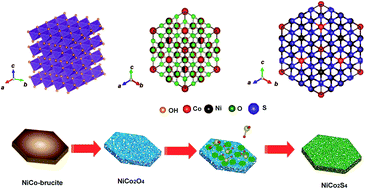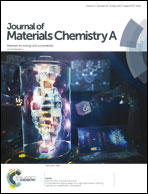Pseudocapacitance-tuned high-rate and long-term cyclability of NiCo2S4 hexagonal nanosheets prepared by vapor transformation for lithium storage†
Abstract
The high conductivity of bimetallic thiospinel NiCo2S4 endows energy storage devices with very fascinating performance. However, the unsatisfactory rate capability and long-term cyclability of this material series significantly limit their large-scale practical applications such as in electric vehicles and hybrid electric vehicles. Herein, we successfully synthesized NiCo2S4 hexagonal nanosheets with a large lateral dimension of ∼1.35 μm and a thickness of ∼30 nm through a vapor transformation method. The dynamic transformation process of the NiCo2S4 polycrystalline nanosheets from NiCo-hydroxide has been revealed in detail. Originating from their two-dimensional thin-sheet structure with a high aspect ratio, the induced extrinsic capacitive contribution as high as 91% makes them an ideal candidate for high-capacity and high-rate lithium-ion anodes. The NiCo2S4 nanosheets deliver a reversible capacity of 607 mA h g−1 upon 800 cycles at a current density of 2 A g−1. This outstanding long cycle performance sheds light on the structural design of electrode materials for high-rate lithium-ion batteries.



 Please wait while we load your content...
Please wait while we load your content...